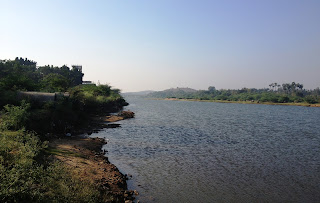The next day, Saturday February 23, was the first full day of our project. As became the usual schedule, we had breakfast at the school at 8:00 with the school students and at 8:30 the auto driver that we had hired to be with us each day, took us into the town. We first went to the town center to see the clock tower built in 1863 and renovated a few years ago.
We then went to Samuel’s house at 9:30 and discussed how to proceed with our project.We started our work of documentation of the heritage buildings at the mosque, ruined darghah (tomb shrine) and ashurkhanah (building for the commemoration of Muharram), along with a godown (storehouse), across the street from St. Ann’s. The local Muslims are Sunnis, but they commemorate Muharram.
At 12:00 we had lunch with the sisters at St. Ann’s and in what became the pattern for the coming days, at 1:00 I took a nap in a guest room, and then we had tea with the sisters.
At 2:00 we went to take a look at a nearby Telugu-medium school in a British building dated to 1861. The building had been renovated recently with Dutch help.
At 2:30 we went back to Samuel’s place and he took us to the Chitavalsa Jute Mills several kilometers to the north. The jute mill had closed four years ago due to labor strife; our auto driver was a former employee.
After we got a tour of the factory, Samuel took us to the Gosthani River near the mills and then to a picturesque vegetable market in the nearby town of Thagarapuvalasa.
We arrived back at the school at 5:00 and we had dinner with the students at 7:30.
The clock tower
We then went to Samuel’s house at 9:30 and discussed how to proceed with our project.We started our work of documentation of the heritage buildings at the mosque, ruined darghah (tomb shrine) and ashurkhanah (building for the commemoration of Muharram), along with a godown (storehouse), across the street from St. Ann’s. The local Muslims are Sunnis, but they commemorate Muharram.
Samuel, the local imam and his wife, with Ilse and me in the ashurkhanah
Ilse at the ruined darghah
At 12:00 we had lunch with the sisters at St. Ann’s and in what became the pattern for the coming days, at 1:00 I took a nap in a guest room, and then we had tea with the sisters.
At 2:00 we went to take a look at a nearby Telugu-medium school in a British building dated to 1861. The building had been renovated recently with Dutch help.
The school
A commemorative plaque at the school
The school students
At 2:30 we went back to Samuel’s place and he took us to the Chitavalsa Jute Mills several kilometers to the north. The jute mill had closed four years ago due to labor strife; our auto driver was a former employee.
The Chitavalsa Jute Mills
After we got a tour of the factory, Samuel took us to the Gosthani River near the mills and then to a picturesque vegetable market in the nearby town of Thagarapuvalasa.
The Gosthani River near the jute mills, visible to the left
We arrived back at the school at 5:00 and we had dinner with the students at 7:30.








No comments:
Post a Comment